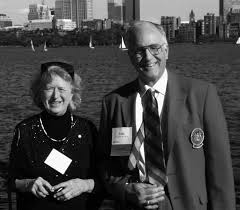Donor Profile: Carol Alonso and Jose Alonso
Carol Alonso PhD ’70 and Jose Alonso ’62, PhD ’67 have made a gift to the Physics Department to support a fellowship.
by Erin McGrath // MIT Physics Annual 2014

Carol and Jose started their physics careers in the heady years immediately following Sputnik, during the wake-up call that first satellite provided for youngsters interested in science and engineering.
Jose’s personal interest in physics came from a one-day visit in 1958 to the Lawrence Berkeley Lab (then the “RadLab”) where, wide-eyed, he was introduced to fascinating and fabulous machines such as the Bevatron, the 184-foot Synchrocyclotron and the Heavy-Ion Linac (HILAC), all working furiously to discover new elements and unravel the newly developing field of particle physics. The serendipity of that visit came home when, 20 years later, after finishing his bachelor’s and PhD degrees at MIT, Jose returned to Berkeley and assumed the directorship of those same machines that had turned him on to the field.
Carol and Jose pursued different paths to their professional physics careers: she through a double major in physics and math at Allegheny College, and Jose through an undergraduate degree at MIT. In Jose’s 1958 freshman class, fully 50% of the students intended to major in physics or electrical engineering, but while many later diverged to other specialties, he continued to enjoy physics. As a senior, Jose joined Prof. Lee Grodzins’ group and conducted a thesis experiment on the newly-discovered Mossbauer effect. Later, when accepted into MIT’s physics graduate program, he continued with Prof. Grodzins in his hyperfine interactions group.
Carol and I owe so much to MIT for the formation of our professional careers and this gift is a small token showing our appreciation. We understand that fellowship support is a top need in the Department, allowing it to recruit the best students and give them flexibility in their first year.
Jose Alonso ’62, PhD ’67
Carol joined the same MIT group about two years later, after finishing a master’s in biophysics at Bryn Mawr. Her MIT PhD thesis on “Perturbed Angular Correlations” landed her in European conferences, as she had discovered a new selection rule. They then both worked as postdoctorates at Yale, transferring a year later to Prof. Glenn Seaborg’s group at Berkeley for another two years of postdoc research. There, their team discovered Element 106, subsequently named Seaborgium after their mentor. During that period Carol also fielded a hydrodynamics experiment on the Space Shuttle Challenger with astronaut Taylor Wang.
Carol then transferred to Lawrence Livermore National Laboratory, managed by the University of California, where she pursued a productive career in Defense Sciences, including management of joint U.S. – U.K. programs in the field and early laser fusion experiments. She was the Deputy “A” Division Leader for several years, then promoted to Assistant Associate Director for National Security in the Director’s Office and Assistant to the Deputy Director. Carol was honored with a United States Medal for Outstanding Service during the Gulf War.
After early retirement in 2001, Carol took on her current career, the training and competing of dressage horses with a specialty in freestyle to music. She has been fortunate to win several awards riding her own horses. In 2009 she earned a Bronze Medal from the United States Dressage Federation and in 2011 was the California Reserve Champion for Second Level Freestyle. Riding, her daily passion, keeps Carol fit and healthy.
Jose remained at Lawrence Berkeley Lab in the Accelerator Division, and pursued a productive career in the development of new applications for particle accelerators, in many of the fields pioneered by the Bevatron and Bevalac. Examples include the use of particle beams for cancer therapy, beams up to uranium for relativistic heavy-ion research, and as part of the SNS project at Oak Ridge, megawatt proton beams as neutron sources for materials research.
After “retirement” in 2002, Jose did a stint at CERN working on the ATLAS detector, then was appointed director of the newly-established Sanford Underground Laboratory in the Homestake mine of Lead, South Dakota. It was there that he met MIT professor of physics Janet Conrad, becoming fascinated with the maelstrom of neutrino physics. Using his expertise in particle accelerators, he is currently helping Prof. Conrad develop a new generation of cyclotrons, primarily as neutrino sources (involving striking targets with megawatt proton beams), but with far-reaching applications in medical isotopes and so-called ADS* areas.
The DAEδALUS Collaboration that Prof. Conrad leads includes scientists, engineers and students from almost 50 institutions and laboratories in the U.S., Japan and Europe, and is a resourceful and dynamic group. Currently, plans are being developed for deployment of experiments at two deep underground sites—in mines in Japan and the U.S.—and this is only the beginning!
Jose comments, “This reconnection with MIT through Prof. Conrad’s research has been a marvelous experience, and it is with great pleasure that we are able to provide a gift that benefits the Physics Department in supporting graduate fellowships. We understand that fellowship support is a top need in the Department, allowing it to recruit the best students and give them flexibility in their first year. Carol and I owe so much to MIT for the formation of our professional careers, and this gift is a small token showing our appreciation.”
* Accelerator Driven Systems (ADS): use of high-energy, high-power beams for nuclear waste transmutation, driving of sub-critical thorium reactors, and other novel applications of particle accelerators in the field of nuclear power.